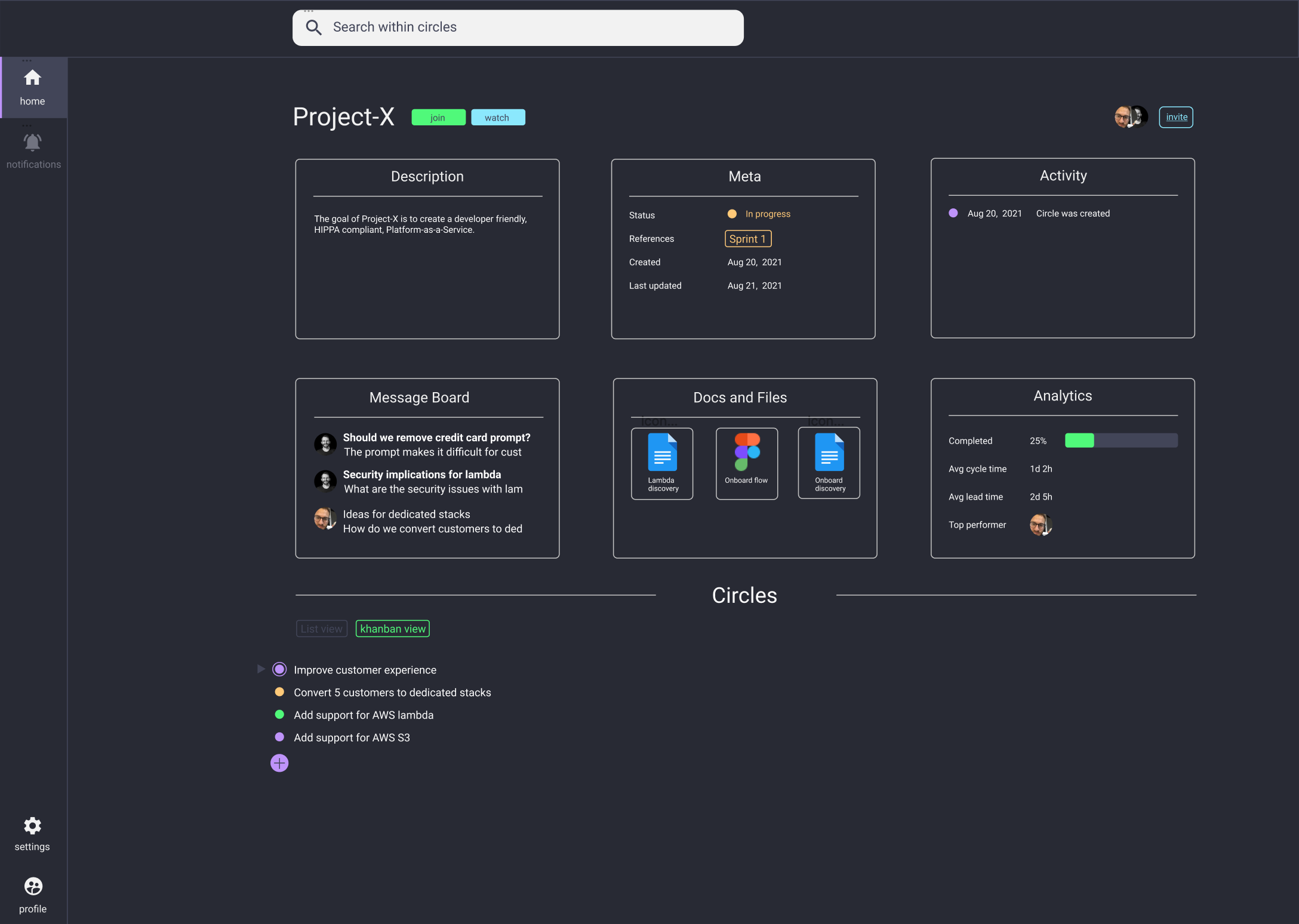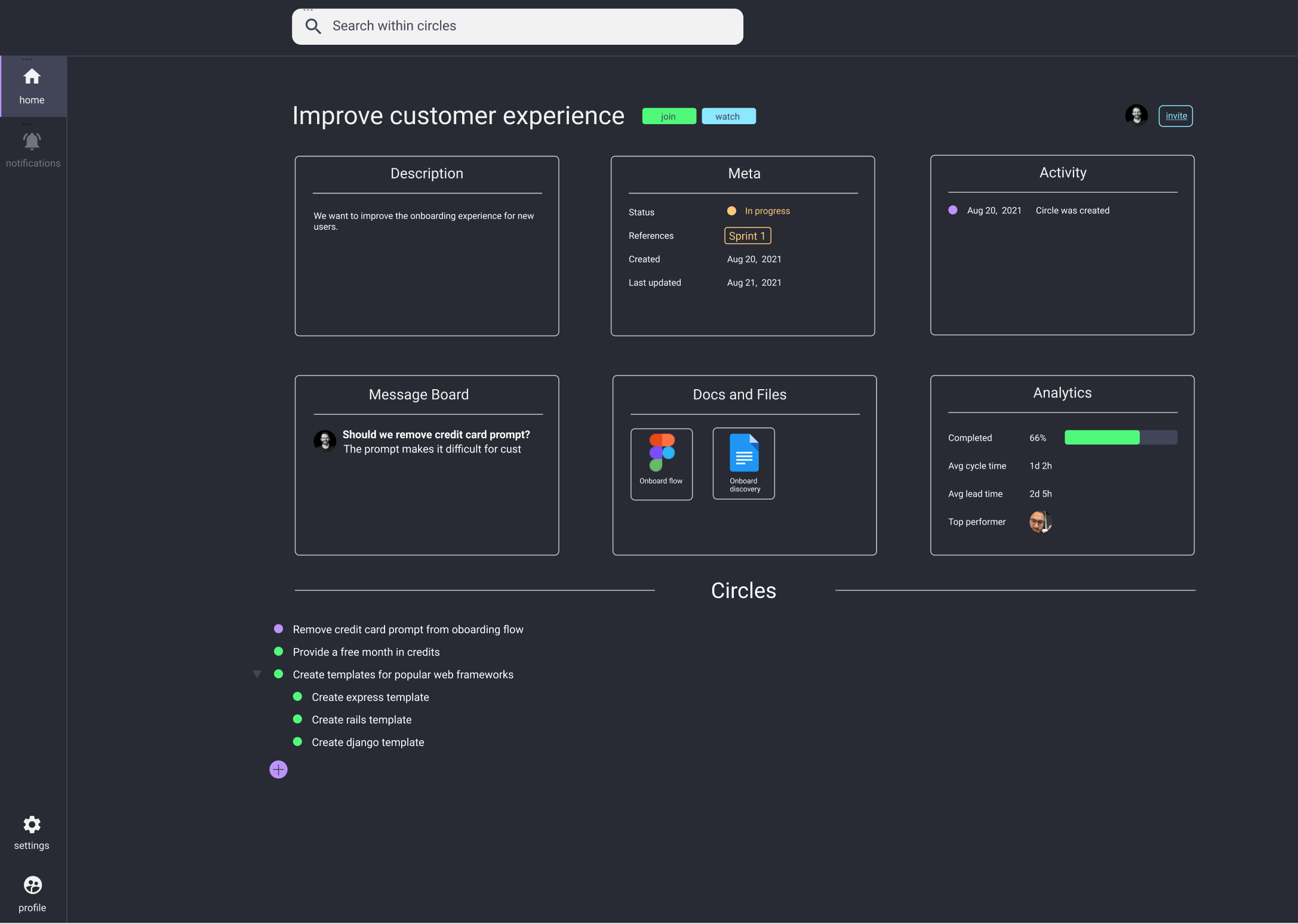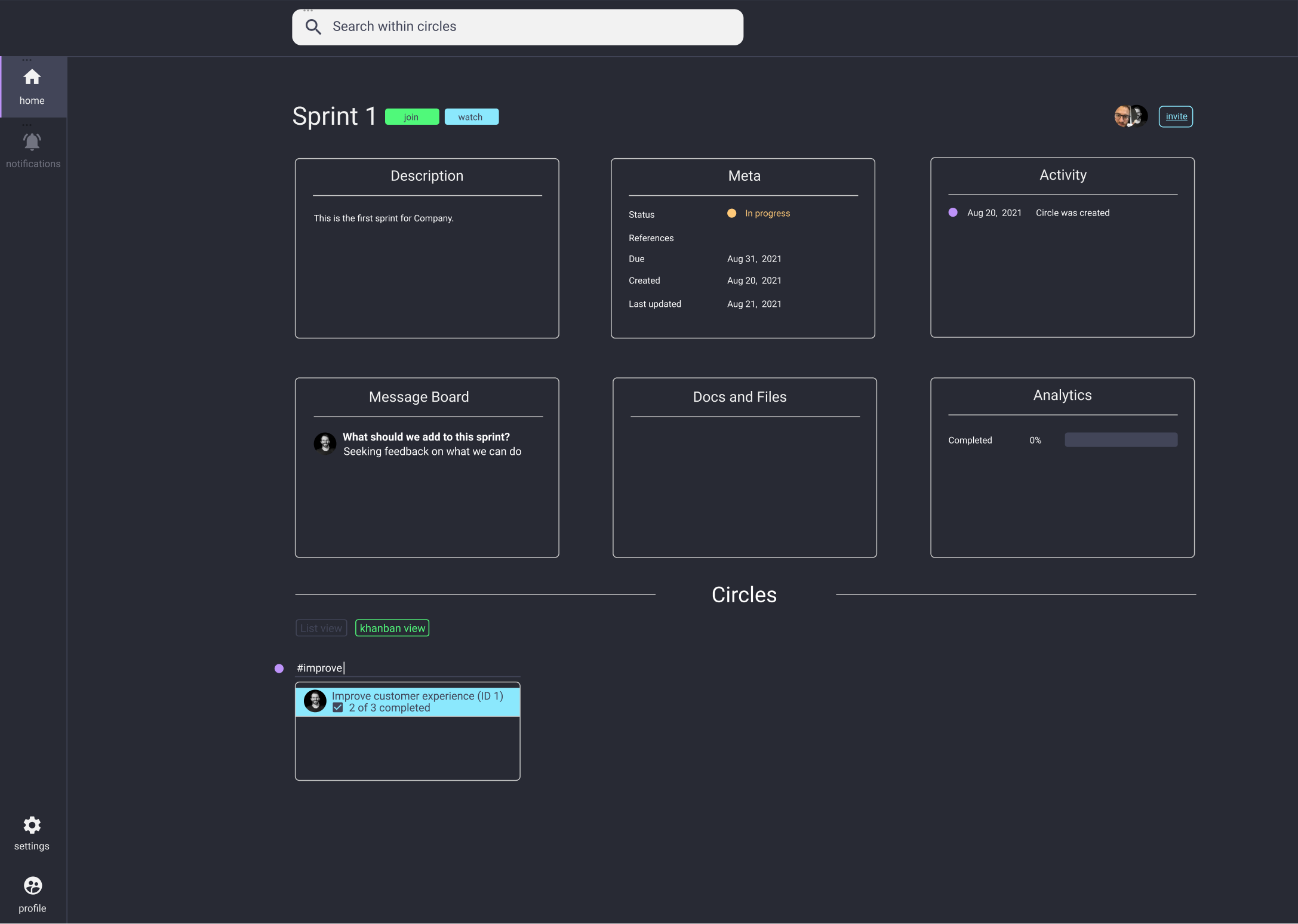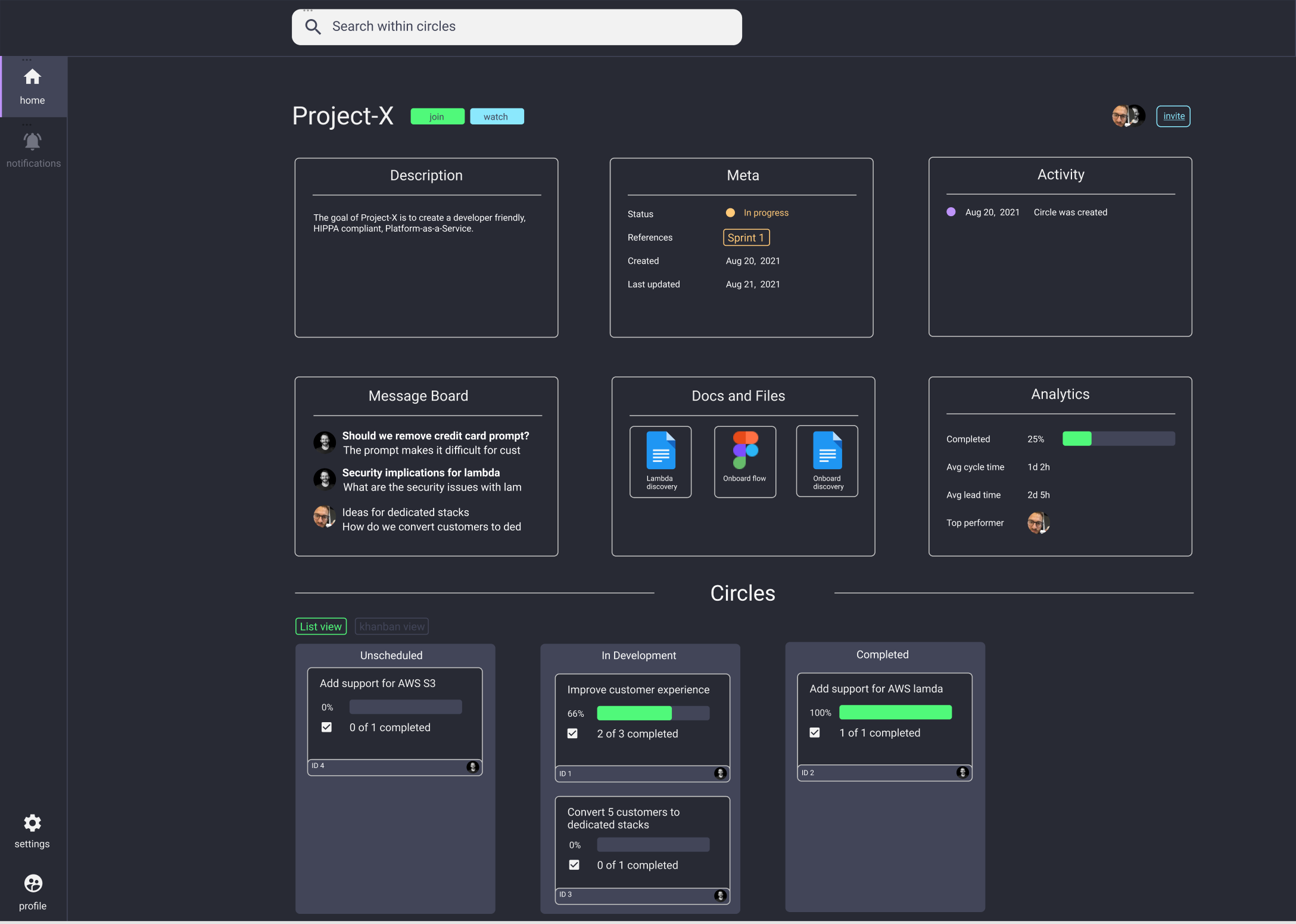Over the last few weeks I've been thinking about the problems I have with project management software and how I think it could be improved.
Research #
I spent some time researching the various different solutions offered as of 2021 and compiled a list of known project management software here.
In my career as a software engineer, the main project management solutions I've tried:
- JIRA
- Pivotal Tracker
- Trello
- Clubhouse
- Basecamp
These apps are the primary target of my critiques.
The problems with project management #
- Glorified company-wide todo list
- Few features for team collaboration
- Rigid and difficult to experiment
- Difficult to scale with a company
- Difficult to couple OKRs (objective and key results) with tasks
Glorified company-wide todo list #
Most project management software revolves around tasks. There might be a different vernacular for what a tasks is (e.g. card, story) but when you break it down to its essence, project management software today is all about tasks.
There are epics, stories, tasks, sub-tasks, and sprints but in the end they all feel like the exact same things. They each have:
- Children (e.g. epics had stories, stories has tasks, etc.)
- Due date
- Status
- Assignees
They have other meta-data attached to them but those three items are at the core for each of them.
I would argue that these concepts are all roughly the same. At every organization I've worked at project management software revolved around sprints. At multiple companies I have taken on the nebulous role of team lead. As far as my project management software was concerned, my entire life revolved around preparing sprints and making sure people had enough to do. However, there was so much more to what I was doing that wasn't captured in the project management software. A huge part of my job was unblocking other teammates and being the bridge of communication between different departments. I tracked my success by the productivity of my teammates.
It felt like JIRA, Clubhouse, Pivotal were all hyper-focused on tasks and sprints and cared little about actual team collaboration. Yes each system had a way to comment on the tasks, but many teams preferred to just talk on Slack because the commenting system in project management software was lack-luster.
Few features for team collaboration #
It has been my experience that all team collaboration happens outside of project management software. We use Slack or Zoom. Why is that? Slack and Zoom absolutely have their place for team collaboration but when it gets abused you end up losing or forgetting importing information. I can't count how many times I've lost information buried in a Slack channel or thread. It's so easy to lose valuable information in Slack. Zoom is the same way. It's ephemeral. Once the call ends you lose all discussions. Yes you can record the calls but I've only gone back to recorded calls a handful of times.
Why can't project management software help with team collaboration? There needs to be a more permanent, organized form of team communication that revolves around the active tasks being worked on. Comments are difficult to reference, difficult to find, and only pertain to the single tasks at hand.
I feel like there is a huge missed opportunity here, one where software like Basecamp has reigned supreme.
Rigid and difficult to experiment #
Let me tell you about my workflow as a team lead getting tasks added to JIRA:
First, I create a Google doc and build an outline of tasks. The google doc is really where I spend most of my time. I experiment with different task items, think about how they are going to be broken down and worked on. I think about who will be working on the tasks. This is where I do all of my editing. Once I feel like I have everything broken down how I like them I finally add the cards to JIRA, assign a person and put them in the next sprint.
My goal when working with JIRA was always to use the software as little as possible. Part of this is just the side-effect of JIRA being unbearably slow to work with, but I feel the pain in other project management software as well, like Clubhouse or Pivotal. The only project management software where I feel comfortable enough experimenting within the software is Trello. Trello makes it easy to add, remove, and move cards around.
Difficult to scale with a company #
I feel like every startup I join starts with Trello and ends up with JIRA. Why do product teams always end up feeling like Trello isn't enough? Clearly they liked it in the beginning because it is easy to use and does a good job of getting out of the team's way. But eventually it isn't enough. Teams want to categorize and create buckets for different objectives and Trello just isn't good enough. But wait, if companies eventually need JIRA, why don't they start with it to begin with? Anyone that has ever used JIRA knows the answer to that question. It can do everything your company needs it to as well as any other software company on the planet. It provides the noose and wraps it around your neck. It's almost to the point of Salesforce in terms of requiring a dedicated expert who knows how to operate JIRA successfully. Everything is customizable and it's dizzying how many different types of configuration systems exist in JIRA.
At the end of the day, I don't think any modern project management software I've worked with really prioritizes scaling with a company.
Difficult to couple OKRs with tasks #
There is a separate suite of software focused on creating and measuring OKRs (objectives and key results) or KPIs (key performance indicators). I've had the opportunity to use some of these software solutions (e.g. lattice) and found them interesting but overall lacking. There was no reason for me to go to these apps on a regular basis. Every quarter me and my boss would come up with a list of OKRs to set for the quarter and then after they were created I almost never went back to look at them again.
We ultimately unsubscribed from the various OKR solutions we tried because it didn't seem valuable enough to use as a startup.
I have a feeling that if we coupled OKRs to our task management system, we'd have more success aligning what our team accomplishes with our company-wide objectives.
A product idea is born #
I want a project management solution that:
- Emphasizes team collaboration
- Is able to scale with a company's growth
- A playground for teams to experiment and build tasks
- Ability to capture OKRs (objectives and key results)
- Task management
With that in mind, I spent the last few weeks coming up with a fresh take on
project management software and I'm tentatively calling it wormhole.

Wormhole is a new spin on project management software. Instead of traditional project management where there is a fixed hierarchy (e.g. epics, sprints, stories, tasks, sub-tasks) we support an infinitely nest-able list of items that we call circles.
Circles can be anything you want them to be. If you want a project hierarchy to look like traditional project management you can. The circle hierarchy is totally up to the team. Want just one board and replicate something simple like Trello or Basecamp? Go for it. Want something more complicated that resembles Clubhouse? Build it.

The thing I really like about this idea is that the user can organize their hierarchy however they like. They are not restricted to what the software defines as an "epic." What if team collaboration and task management revolved around OKRs? Circles can be organized by OKRs and arbitrary metrics can be tracked within the circle.
The top level is sort of the team space starting point. You have to at least create one circle to enjoy all of the features wormhole provides.

For this demo we are just going to create three top-level circles based on two different projects: Project-X, Project-Y, and Sprints.
Once the circles have been created, the user can click on the purple disks to enter the circle.

Once inside the circle you can see a bunch of features.
Message board is most like a forum catered specifically for that circle. It will include all posts created within this circle, including children circles. This concept of bubbling up items from children circles is fundamental to how wormhole works. The deeper you go into the circle tree, the more specific the items are within each section. Message boards are a great way to collaborate around topics and keep them organized by circles. Circles are a natural way to not only organize getting things done, but also filtering through forum posts that are relevant.
As you can see, we have four circles inside of Project-X, one of which is completed (Add support for AWS lambda).
Users can watch or join a circle. Watching means that you want to receive notifications for a circle but are not a member responsible for completing any tasks within a circle.

As you can see by clicking the "Improve customer experience" circle, we now only see message board posts, docs and files, and analytics pertaining specifically to that circle.
You can also see that you don’t have to zoom into a circle to see all the children circles. Users can expand or collapse circles to see the children circles. At any level, users can add, remove, or edit deeply nested circles. This adds a ton of flexibility and allows users to make huge changes within the system from any view.

Circles can be displayed in two different views: list and kanban. This allows users to visualize the circle in different ways.

A circle can easily be a sprint with all the features that people know and love. One awesome feature of wormhole is that you can reference other circles in a circle. This allows us to link circles together allowing for a robust system.
Want to create a sprint? Create a circle and reference other circles within it. Want to create an epic? Create a circle and reference other circles within it. Want to view your circle and its children as a kanban? It supports that. Want to move circles around, such as nesting them or unnesting them? It's as easy as pressing "tab" or "shift+tab." This is the playground for users to experiment and play around with the software. Want to try a completely new hierarchy and are worried about destroying what is already setup? Create another top-level circle and reference other circles as needed.
Even though I built some mockups to get my idea across to you and came up with a name, I have not committed to building this product yet. I need to see some interest from the larger community that this product could be useful and eventually have companies pay for it.
This is just the beginning, but I need input from everyone about this idea. What do you think?